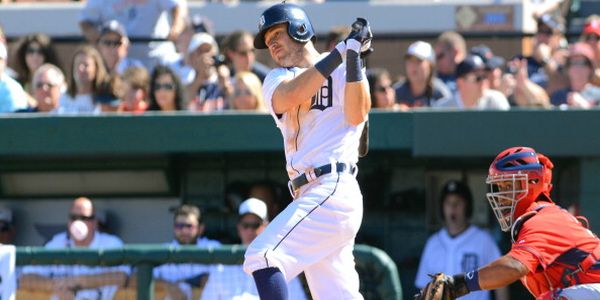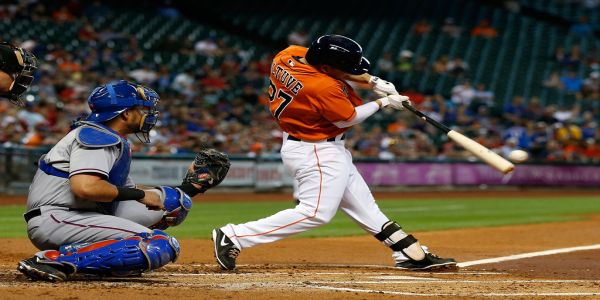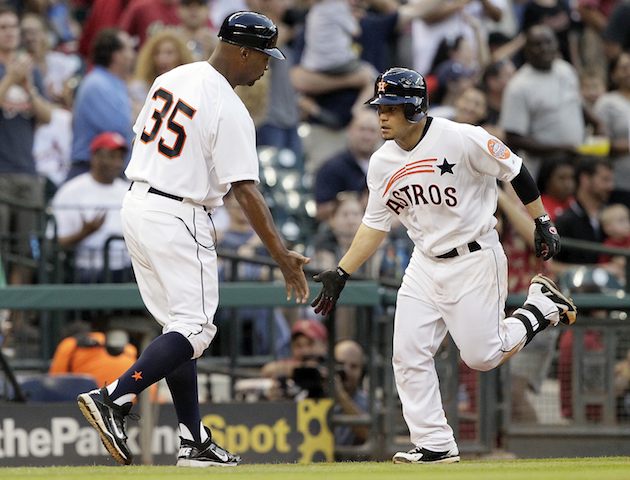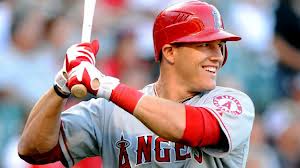2018 Fantasy Baseball: Second Base Total Points H-M

Baseball has always been a thinking man’s game, but sometimes it takes a while for these ideas to become mainstream. Leave it to gamblers to find a way to make these ideas become more popular with the masses. Total points began as a way to introduce daily fantasy baseball to the fantasy public. It has literally become a multi-billion-dollar industry and now full season leagues are beginning to use it.
The advantages of total points include the fact that it takes more events into account. When you include extra base hits and negative events you encompass more of what makes a player unique and valuable (or not valuable). So, the results you get are more accurate. Of course, gambling organizations love accuracy because it helps them guarantee themselves a healthy profit at the end of the day. We are including our own formula to help you handicap these players for your sojourns of the daily fantasy universe. If you like a particular platform you can feel free to adjust accordingly.
Total Bases + Runs + RBI + Walks + SB + HBP – SO – CS – GIDP = Total Points
Ian Happ—Chicago Cubs
| G | TP | Rank | TP/G | Rank | |
| 2017 | 115 | 223 | 1.94 | ||
| AVG | 115 | 223 | 24 | 1.94 | 22 |
Contract Status: Pre-Arbitration
DRS: 0
Happ played five different positions last year and likely will be shuffled around the diamond again with Ben Zobrist in tow. Zobrist also will shuffle around the diamond as both players offer tremendous flexibility to Joe Maddon and fantasy owners. Happ flashed a little more power than was expected, but he will likely come out in a wash as he should have better contact numbers next year as well.
Josh Harrison—Pittsburgh Pirates
| G | TP | Rank | TP/G | Rank | |
| 2017 | 128 | 287 | 2.24 | ||
| 2016 | 131 | 257 | 1.96 | ||
| 2015 | 114 | 201 | 1.76 | ||
| 2014 | 143 | 334 | 2.34 | ||
| AVG | 129 | 270 | 15 | 2.09 | 18 |
Contract Status: Signed Through 2018
DRS: +8
All told, Harrison likely represents the median of everyday second basemen. Thus, we get a pretty good idea of the difference in value between what we would call replacement level and what we would call the average. When you include defense and flexibility he is really a little better than that, but you get the idea. The Pirates have club options on him through 2020, but eventually they will have to decide how badly they want an average player. You shouldn’t overpay for him either.
Cesar Hernandez—Philadelphia Phillies
| G | TP | Rank | TP/G | Rank | |
| 2017 | 128 | 297 | 2.32 | ||
| 2016 | 155 | 271 | 1.75 | ||
| 2015 | 127 | 197 | 1.55 | ||
| 2014 | 66 | 24 | 0.36 | ||
| 2013 | 34 | 46 | 1.35 | ||
| AVG | 102 | 167 | 28 | 1.64 | 29 |
Contract Status: Arbitration
DRS: -1
Hernandez is still relatively cheap labor. If we ignore the first two seasons where he served as a bench player, he approaches two points per game as a regular. So, he is essentially in the same boat as Harrison. He will get you by and likely will be undervalued on draft day. The arrow appears to be pointed up, so he could offer you above average performance for a very cheap price.
Ian Kinsler—Detroit Tigers
| G | TP | Rank | TP/G | Rank | |
| 2017 | 139 | 345 | 2.48 | ||
| 2016 | 153 | 445 | 2.91 | ||
| 2015 | 154 | 391 | 2.54 | ||
| 2014 | 161 | 425 | 2.64 | ||
| 2013 | 136 | 481 | 3.54 | ||
| AVG | 149 | 417 | 3 | 2.80 | 2 |
Contract Status: Signed Through 2018
DRS: +6
The actuary table on long-term deals reads like a depressing obituary. However, it is hard to argue that the Rangers and Tigers didn’t get full bang for their buck on this one. He signed his deal prior to the 2008 season and it expires following this season. The Tigers have been dangling him for years and this might be the best time for all involved to get him in a new uniform. He is still good enough to be a valuable member of a lineup, but he is no longer good enough to carry one. The same is true in fantasy terms.
Jason Kipnis—Cleveland Indians
| G | TP | Rank | TP/G | Rank | |
| 2017 | 90 | 180 | 2.00 | ||
| 2016 | 156 | 370 | 2.37 | ||
| 2015 | 141 | 351 | 2.49 | ||
| 2014 | 129 | 223 | 1.73 | ||
| 2013 | 149 | 374 | 2.51 | ||
| AVG | 133 | 300 | 9 | 2.26 | 11 |
Contract Status: Signed through 2019
DRS: -5
“This is the story of Dr. Heckle and Mr. Jive. They are a person that feels good to be alive.” This obscure 1980s reference (Men at Work) encapsulates Kipnis’ career to date. He did gain center field eligibility next year, so he is that much more intriguing. Is he the all-star performer from 2013, 2015, and 2016 or is he the bench fodder he showed last season and in 2014. Your guess is about as good as mine.
D.J. LeMahieu—Colorado Rockies
| G | TP | Rank | TP/G | Rank | |
| 2016 | 155 | 360 | 2.32 | ||
| 2015 | 146 | 417 | 2.86 | ||
| 2014 | 150 | 309 | 2.06 | ||
| 2013 | 149 | 198 | 1.33 | ||
| 2012 | 109 | 164 | 1.50 | ||
| AVG | 142 | 290 | 10 | 2.04 | 19 |
Contract Status: Arbitration
DRS: +8
Those in the industry and outside can wax poetic about whether he really is this good. He isn’t, but that doesn’t really matter in the short-term. In the long-term the Rockies will have to think hard about how much they want to commit to an average player. The mile-high air will make those skills play up, so every fantasy player should consider buying in at least for this next season. Long-term it’s a little more dicey.
Jed Lowrie—Oakland Athletics
| G | TP | Rank | TP/G | Rank | |
| 2017 | 153 | 373 | 2.44 | ||
| 2016 | 87 | 118 | 1.36 | ||
| 2015 | 69 | 143 | 2.07 | ||
| 2014 | 136 | 259 | 1.90 | ||
| 2013 | 154 | 369 | 2.40 | ||
| AVG | 120 | 252 | 19 | 2.10 | 17 |
Contract Status: Signed Through 2018
DRS: -1
If players are ultimately stocks then Lowrie has to be seen as a depreciating asset. The time to cash in was last July when he was in the midst of a career season. They still might get something of value for him this winter, but his utility as an everyday player is likely limited. He is a super utility guy on a contender and those don’t exactly break the prospect bank. So, he gives the A’s decent performance for a decent price in the meantime.
Whit Merrifield—Kansas City Royals
| G | TP | Rank | TP/G | Rank | |
| 2017 | 145 | 388 | 2.68 | ||
| 2016 | 81 | 146 | 1.80 | ||
| AVG | 113 | 267 | 16 | 2.36 | 9 |
Contract Status: Pre-Arbitration
DRS: +5
If Merrifield had come up three years earlier it is likely that the Royals would have two rings instead of one. Unfortunately, he gets to be the lone bright spot on a moribund roster. That’s sometimes how delicate the timing is for middle market teams. The decaying nature of the roster will limit his value some, but he is still an under the radar gem at a position that has a number of them.
Brad Miller—Tampa Bay Rays
| G | TP | Rank | TP/G | Rank | |
| 2017 | 110 | 149 | 1.35 | ||
| 2016 | 152 | 316 | 2.08 | ||
| 2015 | 144 | 216 | 1.50 | ||
| 2014 | 123 | 158 | 1.28 | ||
| 2013 | 76 | 178 | 2.34 | ||
| AVG | 121 | 203 | 26 | 1.68 | 28 |
Contract Status: Arbitration
DRS: -4
Watching small market teams approach trying to remain competitive is fascinating at times. The Rays strategy appears to be acquiring numerous similar players in the hopes that they will catch lightening in a bottle. Miller struck gold in 2016, but that increasingly looks like a fleeting moment in the sun. 2018 likely represents his last chance to really stick as a regular and if the Rays do what they’ve done in the past, they will have others in waiting.
Daniel Murphy—Washington Nationals
| G | TP | Rank | TP/G | Rank | |
| 2017 | 144 | 442 | 3.07 | ||
| 2016 | 142 | 492 | 3.46 | ||
| 2015 | 130 | 323 | 2.48 | ||
| 2014 | 143 | 324 | 2.27 | ||
| 2013 | 161 | 389 | 2.42 | ||
| AVG | 144 | 394 | 5 | 2.74 | 3 |
Contract Status: Signed Through 2018
DRS: -15
You could certainly argue that the three-year contract Murphy signed turned out to be the most team friendly contract in baseball history. 37.5 million over three seasons certainly isn’t chump change, but you could also claim he has been one of the top five players in the National League since October of 2015. Sadly, his long-term prospects of staying at second base are likely limited given his consistently below average performance with the glove. Enjoy the second base eligibility while you can.




